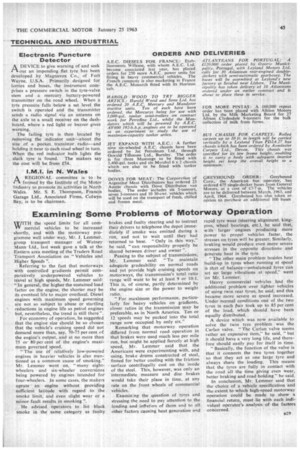Examining Some Problems of Motorway Operation
Page 47

If you've noticed an error in this article please click here to report it so we can fix it.
WITH the speed limits for all commercial vehicles to be increased shortly, and with the motorway programme well under way, Mr. J. Lemmer, group transport manager of Watney Mann Ltd., last week gave a talk at the Eastern area meeting of the Traders Road Transport Association on "Vehicles and Higher Speeds ".
Referring to the fact that motorways with controlled gradients permit comparatively underpowered vehicles to travel at high speeds, Mr. Lemmer said: "In general, the higher the sustained load factor on the engine, the shorter may be its eventual life to major overhaul. Diesel engines with maximum speed governing are not so subject to abuse or startling reductions in engine life as petrol engines but, nevertheless, the trend is still there ".
For economy of operation, he suggested that the engine size should be so chosen that the vehicle's cruising speed did not demand more than, say, 70-75 per cent of the engine's output, and at no more than 75 or 80 per cent of the engine's maximum governed speed.
"The use of relatively low-powered engines in heavier vehicles is also mentioned as a common cause of smoking," Mr. Lemmer went on, "many eightwheelers and six-wheeler conversions being powered by engines intended for four-wheelers, In some cases, the makers uprate ' an engine without providing sufficient latitude with regard to the smoke limit, and even slight wear or a minor fault results in smoking ".
He advised operators to list black Smoke in the same category as faulty
brakes and faulty steering and to instruct their drivers to telephone the depot immediately if smoke was emitted during a run, and not to wait until they had returned to base. "Only in this way," he said, "can responsibility properly be shared between driver and owner ".
Passing to the subject of transmissions, Mr. Lemmer said: "To maintain adequate gradeability on normal roads and yet provide high cruising speeds on motorways, the transmission's total ratio range will want to be at least 9 or 10:1. This is, of course, partly determined by the engine size or the power to weight ratio.
"For maximum performance, particularly for heavy vehicles on gradients. closer ratios in the transmission may be preferable, as in North America. Ten or 12 speeds may be packed into the total range now occupied by only six."
Remarking that motorway operation differed from normal road. operation in that brakes were used much less per mile run, but might be applied fiercely at high speed, Mr. Lemmer said that the Americans were experimenting with, and using, brake drums constructed of steel, finned for better cooling with the friction surface centrifugally cast on the inside of the steel. This, however, was only an intermediate measure and disc brakes would take their place in time, at any rate on the front wheels of commercial vehicles..
Examining the question of tyres and stressing the need to pay attention to the loading and inflation of them and to all other factors causing heat generation and
rapid tyre wear (steering alignment, kingpins, wheel bearings, etc.), he said that, with larger engines producing more power to propel vehicles faster, the stresses on tyres will be greater. Similarly, braking would produce even more severe stresses in the opposite directions and generate heat in the tyre.
" The other main problem besides heat build=up in tyres when running at speed is that of balance—unbalanced tyres can set up large vibrations at speed," went on Mr. Lemmer.
Heavy commercial vehicles had the additional problem over lighter vehicles of using twin rear tyres, he said, and this became more severe as speed increased. Under normal conditions one of the two tyres in each pair took up to 85 per Cent of the load, which should have been equally distributed.
A device which was now available to solve the twin tyre problem was the Carlan valve. "The Carlan valve seems rather an expensive item," he said, " but it should have a very long life, and therefore should easily pay for itself in time.
"Basically, the function of the valve is that it connects the two tyres together so that they act as one large tyre and always share the loading. This means that the tyres are fully in contact with the road all the time giving even wear, better braking and road holding he said.
In conclusion, Mr. Lemmer said that the choice of a vehicle specification and the extent to which high-speed motorway operation could be made to show a financial return, must lie with each individual operator's analysis of the factors concerned.
















































































































